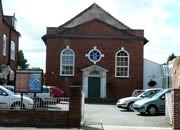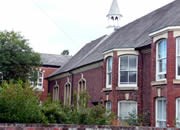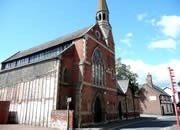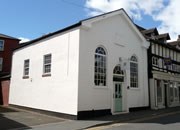 The history of this faith can easily be traced back to the time of the Commonwealth. The Vicar of Leominster at this time was the Reverend John Tombes (born 1603) who was a supporter of the reformation of the Established Church. John Tombes had been sent to the University of Oxford at the age of 15 and was a well-educated man, later becoming the "catechetical lecturer" in Magdalene Hall.
The history of this faith can easily be traced back to the time of the Commonwealth. The Vicar of Leominster at this time was the Reverend John Tombes (born 1603) who was a supporter of the reformation of the Established Church. John Tombes had been sent to the University of Oxford at the age of 15 and was a well-educated man, later becoming the "catechetical lecturer" in Magdalene Hall.
After publishing a sermon in which he supported the reformation of the church he was left open to persecution and driven from his home, leaving all his belongings. He was later appointed preacher at the Temple but after publishing a treatise against infant baptism was dismissed. Tombes was then invited to Leominster, became the minister of the Parish, and began gathering a separate church of Baptists who believed in adult baptism. He died at the age of 73.
Some of the members of Tombes' church believed in his views more strongly than he and so formed a separate Baptist church of some 40-50 members, which was constituted on 7th July 1656 and held its first meeting at the home of Mr. Joseph Patshall, in Leominster. The members of the church suffered much persecution because of their beliefs, but they were faithful and the church began to grow in numbers. They still met in private houses but had no permanent pastor.
In 1694 the members that had stayed with the church set up by John Tombes sought the Fellowship of the Baptist Church, along with another society of the Baptists in Leominster led by Mr. Rowland Stead. An appeal was put to the Association, which then met at Pershore, and after a visit by Mr. John Eccles a church was organised and the Baptist Church in Leominster continued to grow.
In 1696 Mr. John Davis, a man of considerable property in nearby Eardisland, gave the congregation a house with back buildings and garden in Etnam Street. The house was fitted for public service and part of the garden was used as a burial ground.
As the years passed there was some increase in numbers but this was at times outweighed by the decrease. When Joshua Thomas settled in Leominster as pastor in 1754 there were only 14 members in the town, with other members living some distance away.
In 1771 Mrs Mary Marlow built at her own expense the present chapel. She also built a minister's house and two cottages for poor widows of the Baptist Church. She died in 1778 and was buried in the burial ground behind the chapel. She also left £2 1s 8d yearly for the Baptist Sunday School, 13s 10d to be distributed to the poor of Leominster and the same amount to be distributed to the poor of the Baptist Church.
The chapel has since this date been under the ministry of a variety of pastors and in 1883 under the ministry of Reverend W. H. Purchase a great revival took place and along with it the promise of great prosperity. In 1885 the chapel was renovated at a cost of £200: the re-opening service aroused much interest and over 30 members were received into the fellowship in that year. The following year the Sunday School was doing so well that schoolrooms were considered.
 The Moravian Church is also known as the Protestant Church of the "United Brethren". It has its first Memorial Day in 1457 after John Huss, a Bohemian Reformer, was burned at the stake in 1415, and his ashes thrown into the Rhine. His followers then broke into different factions, but 10 years later were brought together as one church. This church appointed ministers of their own election and lot, receiving Episcopal ordination from the Austrian Waldenses. The church grew and soon embraced most of Bohemia and Moravia, and then spread further into Poland, embracing three Provinces each with its own Bishop and Synod. Thus the Moravians were a reformed church some 60 years before the Reformation in England.
The Moravian Church is also known as the Protestant Church of the "United Brethren". It has its first Memorial Day in 1457 after John Huss, a Bohemian Reformer, was burned at the stake in 1415, and his ashes thrown into the Rhine. His followers then broke into different factions, but 10 years later were brought together as one church. This church appointed ministers of their own election and lot, receiving Episcopal ordination from the Austrian Waldenses. The church grew and soon embraced most of Bohemia and Moravia, and then spread further into Poland, embracing three Provinces each with its own Bishop and Synod. Thus the Moravians were a reformed church some 60 years before the Reformation in England.
By 1627, after much persecution, the Moravian Church had almost become extinct. In 1722 a settlement was set up in Herrnhut in Upper Lusatia (a Protestant country) and refugees of this religion came here to join together. The followers formed themselves into a distinct religious society, but one that was still within the Protestant National Church, and took their place among the Reformed Churches.
The first Moravian Church in Great Britain was in Fetter Lane in London, set up in 1742. In 1749 the Moravians were recognised as a Protestant Episcopal Church, securing privileges in both this country and the colonies.
About a year after the establishment of the Fetter Lane Society (an association of members of various non-conformist groups) in 1735, a few members of the Established Church in Leominster began to hold meetings in the houses of Messrs. Samuel and Edmund Davis, in the Corn Square. At these meetings sermons of men such as Dr. Beveridge and George Whitfield were read and enjoyed. In 1741 George Whitfield preached in the Corn Square in Leominster, and the need for someone to preach the "Truth" to them became great. In the same year two members of the church heard a Mr. James Beaumont preach at Dilwyn and invited him to preach to them. Mr. Beaumont had been acquainted with the Moravians in London and adopted their simple way of presenting the "Truth". He was found acceptable and this band of followers began to meet in a room in the Back-lane of Leominster.
In 1748 one of their number attended the Ministry of the Moravian Evangelist John Cennick in Dublin. Mr. Cennick was then invited back to Leominster and the great interest created by his visit in 1749 caused a petition, signed by 15 adult members of the church, to be sent to the Moravian elders in London asking for their spiritual oversight.
In 1757 the Society sent a further petition to the elders asking to be received into full connexion and affiliation took place on 9th September 1759. The foundation of the present chapel was laid on 29th April 1760 and the opening ceremony was held on 18th January 1761. A minister's house was also built and ground behind the chapel was set aside as a burial ground. In 1872 the present schoolrooms were built.
The founder of this religion was George Fox, who was born the son of a weaver at Drayton in Leicestershire in 1624. George Fox spent much of his time wandering about the country searching for the "Truth", and deciding that no current sect could supply it for him he broke away from all. He began preaching at Dunkinfield in 1647 and was successful there and elsewhere in the country.
The Quaker doctrine was not entirely new and elements of it can be traced in many of the other non-conformist sects, such as the non-use of the sacraments. But they put emphasis on other spiritual truths such as the authority of conscience and the mysterious union of Christ with the soul of man.
Many of the Quakers' beliefs brought them persecution, such as the refusal to pay tithes, their belief that war went against the teaching in the Gospel, their forbidding of lawsuits, and their simplicity of dress and lifestyle. During the reign of Charles II Acts of Parliament were passed to stamp out dissenters; in 1662 more than 4,000 Quakers were in prison at one time, and some were actually shipped out to America and the West Indies as slaves on the plantations.
The Act of Toleration of 1689 secured the religious liberty of the non-conformist religions, and although it did not repeal all the bad laws made against the dissenters it did help ease some of the bigotry and persecution. In 1695 a bill was passed in Parliament allowing the solemn affirmation of a Quaker, instead of an oath. In 1827 they became eligible for public office.
In the reign of Charles II the Quakers became more organised and meetings were formed. Immediately the attention of this sect was turned to the care of the poor, the registration of births and deaths, education, certificates to ministers, and the record of the suffering of their members in maintaining their principles.
After the death of George Fox the membership of the Quakers began to decline, partly due to the loss of its leader and partly due to the acceptance of many of its doctrines by other churches.
The Quakers first appeared in Leominster in 1654, but the first record is in 1656. They held their meetings in the house of Henry Bedford, an attorney. Their numbers soon became too large and the house too small, so meetings were held in the field next door. This was when the persecution started. The vicar and the magistrates opposed the meetings and one open-air preacher who refused to stop was thrown in jail. George Fox visited the town in 1657, and he preached for three hours at a well-attended open-air meeting.
It was well known that Quakers would not swear an oath on scripture grounds, but one common way of ensnaring them was to tender the oaths of allegiance and supremacy. On one occasion five Quakers were brought before the bailiff, and because they refused to "swear" they were sent to prison. Leominster gaol was soon full with people imprisoned in this way.
When George Fox visited Leominster for a second time in 1667 the society was organised, but the records still speak of persecution. Nicholas Day of Eardisland had eight oxen, worth 32s 1d, taken from him for holding a meeting in his house. This punishment was meted out to others who held these meetings.
In 1660 the site of the Meeting House and burial ground was purchased in Leominster, and the buildings were erected in 1689. The adult School of the Quakers was founded in 1858. By 1886 the women's school met in the Green Lane Room and the men in the Mission Room in Etnam Street, which is now the Leominster Folk Museum. By 1885 there were 10 teachers and 181 scholars, as well as a library with over 500 books.
The Quakers in Leominster even set up their own Orphan Homes. In 1869 a small house was rented for 12 children but by 1870 they had accepted 18 and the following year this had risen to 31. Westfield Villa was then rented and two matrons appointed, one for the boys' house and one for the girls'. In 1871 a Home in Ryelands Road was built. Later a large warehouse in Broad Street became vacant and this provided an excellent space for a printing office, which gave the boys a trade. So the Orphans Printing Press was opened, a business which is still going strong today.
 In religious opinion these two groups resemble each other quite closely, but the way in which they were governed varied. Presbyterianism meant government by a synod of co-ordinate and co-equal elders and Congregationalism or Independency meant self-government by the individual congregation.
In religious opinion these two groups resemble each other quite closely, but the way in which they were governed varied. Presbyterianism meant government by a synod of co-ordinate and co-equal elders and Congregationalism or Independency meant self-government by the individual congregation.
The first Presbyterian Synod in England was established at Wandsworth in 1572, with eleven elders chosen to form a court. This Synod was considered dangerous by the bishops who persuaded Queen Elizabeth I to enforce the Act of Uniformity. In spite of this religious opposition the newly-formed presbytery continued its work and other presbyteries were formed elsewhere in the country.
Towards the end of the reign of Elizabeth and at the beginning of the reign of James I, non-conformists who had separated from the Established Church began to emigrate to Holland. This marked the rise of Independency.
The Presbyterians and Congregationalists both believed that religion was a matter of personal conviction and that a church must be the result of the consent of those who constitute it. In 1609 the Reverend Henry Jacob, a member of the Congregational Church that had been meeting in secret at Southwark, addressed the State praying that "Toleration and Liberty might be granted to all loyal subjects to enjoy and observe the ordinances of Jesus Christ".
The first Presbyterian minister in Leominster was the Reverend William Woodward M.A. He had been a tutor at Oxford University and had recently been ejected as minister at Richards Castle. He remained in Leominster up until his death in 1691. In 1719 a Presbyterian chapel was built in Burgess Street in Leominster. The minister of this chapel was Reverend B. Lewis, who later became one of the trustees of the almshouses in the Bargates. Unfortunately, by the year 1767 the members of this chapel were down to around six.
In 1864 the Presbyterians liaised with the Gloucestershire and Herefordshire Congregational Union to give their aid in affecting a change that would benefit the religious interests of the neighbourhood - a new chapel. In 1867 the old chapel was pulled down as it was too old to renovate and a new one, in the more ostentatious gothic style, built in its place.
The Reverend Patrick Thomson M.A. of Bristol was the first Reverend of the Congregational Chapel. Rev. Thomson helped secure the finances needed to purchase a cottage and garden adjacent to the church for a Sunday School. The schoolroom was built at a cost of £200 and opened in 1880.
On April 2nd 1884, a new organ was installed by Messrs. N. Heins of Hereford and R.T. Heins of Brecon. The chapel was still in use two years later under the ministry of the Reverend D. A . Brown.
 The Evangelical movement that is associated with men like George Whitfield and John Wesley began its rise around the middle of the 18th century. Methodism took its form from Puritanism but it also had its special features and may even be called a second Reformation. England at the beginning of the 18th century was religiously dark and sombre. Vice was looked upon with indifference and in the new large towns the poor living conditions of the people bred many "evils".
The Evangelical movement that is associated with men like George Whitfield and John Wesley began its rise around the middle of the 18th century. Methodism took its form from Puritanism but it also had its special features and may even be called a second Reformation. England at the beginning of the 18th century was religiously dark and sombre. Vice was looked upon with indifference and in the new large towns the poor living conditions of the people bred many "evils".
John Wesley's ancestors had been Non-conformists, but his parents had joined the Established Church and his father was Rector of Epworth, who preached with independence and zeal, and who was interested in the religious controversies of the time. John Wesley later became his father's curate, but was called to return to the University of Oxford, where he had received his education, by his college Rector. It was during his time at Oxford that a small religious group was formed with John Wesley at its head. This group, nicknamed the "Methodists" because of their methodical way of learning, were bound by their religious views and literary study.
Rules for this society were drawn up by John Wesley and they included: agreeing to fast two days in the week, to observe strict self-examination and once a week to partake in the Lord's Supper. Wesley was later influenced by the Moravian spiritualism and the idea of reforming the Established Church by forming smaller churches within it.
Wesley visited Leominster on 14th August 1746, and because of this visit it is supposed that a Methodist Society was set up in the town. By the beginning of the 19th century the Methodists in Leominster were meeting in various private houses in West Street, Broad Street and Burgess Street. About 1836 a chapel was built in Burgess Street, but this was later sold to the Roman Catholics when it became too small for the Methodist congregation.
In 1861 a new Methodist Chapel was opened in the same street. Leominster soon became the hub of the Methodist activity in the area. Later a building in Rainbow Street was taken as a schoolroom and for mission purposes. Gradually chapels began to be erected in the small villages surrounding the town.
This form of Methodism grew up about 70 years after the rise of Wesleyan Methodism. Its pioneers were Hugh Bourne and William Clowes, who had been active members of the Wesleyan Methodist movement. They were impressed by reports of the successes of camp meetings that had been held in America, and in 1807 they held the now-famous Mow Cop Camp Meeting. However, opposition to these camp meetings was strong among the Wesleyans and they disclaimed any connection with them, believing such an event improper in England. Mr. Bourne and Mr. Clowes continued to hold camp meetings and were eventually expelled from the Methodist religion, whereupon they set up their own society, the Primitive Methodists.
The Primitive Methodist Society began its work in Leominster in 1821 when Mr. Lloyd, a "Missionary", visited the town and conducted an open air service in Corn Square. Dr. Lewis, the bailiff, strongly objected to this service and Mr. Lloyd was moved on to the Bargates. Mr. Lloyd stayed on in Leominster and a class was formed in 1822 with the members meeting weekly for conference and religious exercises. A room was hired and fitted out so that many could come and hear the Gospel. The Primitive Methodists later held meetings in houses in Burgess Street and Broad Street.
These meetings were so crowded that it was decided that it was necessary to build a chapel. At this time Hugh Bourne, the founder of Primitive Methodism, visited the town and, perhaps as a result of this visit, a chapel was built and opened in Green Lane in 1839. It was part of the Ludlow Circuit and the services were principally conducted by travelling preachers.
By 1873 the chapel had grown too small for the society, which was ever increasing in numbers, and a new chapel was built at a cost of £400. It opened in 1873.
This page was written with the assistance of Eric Turton of Leominster Folk Museum.
[Original author: Miranda Greene, 2003]